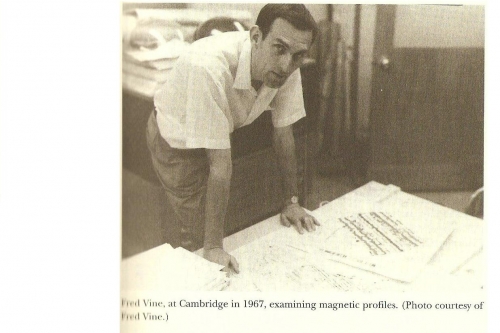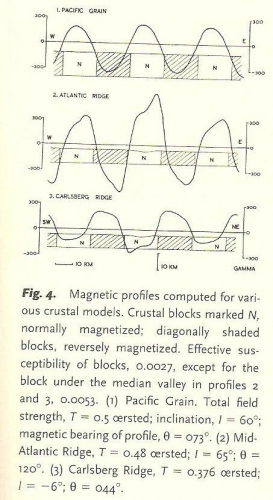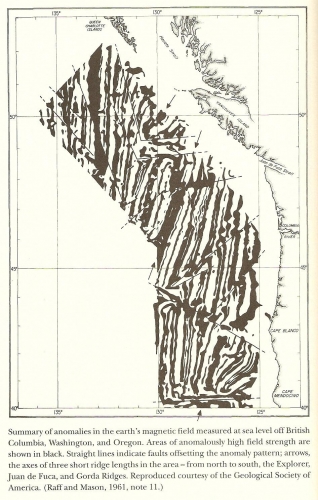Biographical Information

(Image #1. Photo from Reversals of Fortune, p. 47.)
Fred Vine was born in London, England on June 17, 1939. After receiving an education at Latymer Upper School in West London, he attended St. John's College at Cambridge University, where he obtained an undergraduate degree in Natural Sciences and a PhD in Marine Geophysics. He has had a long and distinguished career and has held many titles, among which are Assistant Professor of Geology and Geophysics at Princeton University (1967-1970); Reader and then Professor in the School of Environmental Sciences at the University of East Anglia, Norwich (1970-1977); and Dean of the School of Environmental Sciences at the University of East Anglia (1977-1980, and 1993-1998), where he remains, at age 69, as a Professorial Fellow. Vine has lived to see the fruits of his labors, and with Drum Matthews, has received many awards, including the Chapman Medal of the Royal Astronomical Society, the Charles Chree medal and prize of the Institute of Physics, the Hughes Medal of the Royal Society, and the International Balzan Prize.
Specific contributions to plate tectonic theory
When Vine entered the Department of Geodesy and Geophysics at Madingley Rise, Cambridge in Fall of 1962, he was given the task of reviewing published magnetic surveys of the ocean floor obtained by Dr. Drummond (Drum) H. Matthews, among others. In fact, Vine was Matthews' first research assistant, as Matthews himself had only entered the department as a graduate student four years prior to Vine's arrival.
Matthews spent much time in the Indian Ocean collecting data, and Vine, with the help of colleagues from Imperial College in London, created 3-D computer software to calculate magnetic anomalies of the ocean ridges and surrounding areas that Matthews had observed. In 1963, Vine authored a paper (using Matthews' data) entitled "Magnetic Anomalies over Ocean Ridges" which was published in Nature that same year. Without referring to it as such, the contents of the paper showed proof that continental drift had indeed occurred. Vine and Matthews explained that there are blocks of ocean crust that contain magnetized rocks, some of which are oriented along with Earth's present magnetic field, and others that are opposite (see Image #2 below). Using Harry Hess's proposal that new oceanic crust is formed as a result of upwelling, molten rock, Vine and Matthews explained that the iron-bearing minerals in the new rock become magnetized in the direction of the Earth's magnetic field at that time. Thus, the ocean's crust acts as a "tape recorder" for magnetic reversals, with its zebra-like stripes of normal and reversed polarity (see Image #3 below).
The Vine-Matthews Hypothesis wasn't initially well-received, and Vine and Matthews themselves felt they needed further evidence. That would happen two years later, when Tuzo Wilson, Harry Hess, and Vine all came together in Cambridge. Wilson, having formulated the idea of transform faults, had deduced that there should be a ridge between two faults off the coast of Washington and Oregon. Vine happened to have a map and detailed magnetic survey of the very area Wilson was discussing, and sure enough, there was a ridge -- one Wilson later named the Juan de Fuca Ridge (the dark strip in the center of Image #3, below). And even more, the magnetic stripes on either side of the ridge showed nearly perfect symmetry, with Wilson's faults explaining the slight shifts. These magnetic anomalies provided excellent examples of the phenomena Vine and Matthews had discussed in their earlier paper. Wilson and Vine submitted two papers containing their findings to Science in the summer of 1965, and both were published that fall.
In 1966, Vine was able to take this idea one step further, and, using the timescales of normal and reversed polarity, deduced that the seafloor spreads at essentially a constant rate.
Click here to watch Fred Vine describe paleomagnetic reversals, courtesy of YouTube!
Image #2. Image #3.
(From Magnetic Anomalies over Ocean Ridges, p. 141.) (From Reversals of Fortune, p. 48.)
 --------------
--------------
Other interesting scientific contributions
Vine notes in Reversals of Fortune (p. 65) that his "... One regret, as a geologist, was that this detailed record, written within the 60 percent of the earth's surface covered by oceanic crust, is only available for 4 percent of geologic time. Earlier phases of continental drift would have to be deduced from the more complex and fragmentary geological record within the 40 percent of the earth's surface covered by continental crust." Perhaps this is what led him to study the Troodos Mountains of southern Cyprus with Eldridge Moores in the late 1960s and early 1970s. Vine and Eldridge deduced that the mountains were the result of ocean floor being thrust upward, and studied the physical and internal properties of the area.
With R. A. Livermore and A. G. Smith, Vine has made contributions on the history of Earth's magnetic field, and with Russell Ross has done studies on rocks from the lower continental crust to determine electrical conductivity.
Further cool stuff you should know
Vine admits that he became interested in geology, quite by accident, while studying for the geography portion of his upcoming "O" (Ordinary) level exams at the age of 15. The textbook he was reading noted that geologists had no way to confirm that South America and Africa had once been connected, despite their similar coastlines. "It seemed to me that one could hardly conduct any meaningful study of the history of the earth until one had resolved this issue," he states in Reversals of Fortune (p. 49). He carried this desire to learn more about continental drift with him to Cambridge, a place where the Department of Geodesy and Geophysics "was a very friendly and happy place... [where] coffee and tea breaks were something of an institution."
Another noteworthy mention to Vine and Matthews' hypothesis was that at the very same time Vine was penning their paper, a geologist by the name of Lawrence Morley from the Canadian Geological Survey was writing a similar paper, and in fact, submitted it to Nature before Vine and Matthews submitted theirs. Nature rejected Morley's paper on the grounds that it was "too radical and speculative" (p. 57). He then submitted it to the Journal of Geophysical Research, but it was again rejected, with a note to add insult to injury: "[The] idea is an interesting one -- I suppose -- but it seems most appropriate over martinis, say than in the Journal of Geoophysical Research." At that point, Morley admits he "felt frustrated with the system," and shifted his career focus to satellite remote sensing (p. 84). Vine became aware of Morley's paper in the late 1960s, and now the theory is referred to as the Morley-Vine-Matthews Hypothesis.
Bibliography
Fred Vine explaining Paleomagnetic reversals. In YouTube. Retrieved Feb. 9, 2009, from https://www.youtube.com/watch?v=CRx66ZpEhOg&feature=PlayList&p=96FD9BB9C....
Lerner, K. Lee and Brenda W. (2006). Vine, Fred J. (1939- ). In World of Earth Science. Retrieved Feb. 4, 2009, from http://www.enotes.com/earth-science/vine-fred-j.
McKenzie, Dan (2003). Seafloor Magnetism and Drifting Continents. In Laura Garwin and Tim Lincoln (Ed.) A Century of Nature: Twenty-one Discoveries that Changed Science and the World (pp 131-137). Chicago, IL: The University of Chicago Press.
Morley, Lawrence W. (2001). The Zebra Pattern. In Naomi Oreskes (Ed.) Plate Tectonics: An Insider's History of the Modern Theory of the Earth (pp 67-85). Boulder, Colorado and Cumnor Hill, Oxford: Westview Press.
Transform Plate Boundaries (2005-2009). In Geology.com. Retrieved Feb. 18, 2009, from http://geology.com/nsta/transform-plate-boundaries.shtml.
Vine, F. J., and Matthews, D. H. (1963). Magnetic Anomalies over Ocean Ridges. In Laura Garwin and Tim Lincoln (Ed.) A Century of Nature: Twenty-one Discoveries that Changed Science and the World (pp 138-144). Chicago, IL: The University of Chicago Press.
Vine, Frederick J. (2001). Reversals of Fortune. In Naomi Oreskes (Ed.) Plate Tectonics: An Insider's History of the Modern Theory of the Earth (pp 46-66). Boulder, Colorado and Cumnor Hill, Oxford: Westview Press.
Vine, Frederick J. (2009). In Wikipedia, the free encyclopedia. Retrieved Feb. 4 and 9, 2009, from http://en.wikipedia.org/wiki/Fred_Vine.